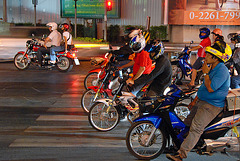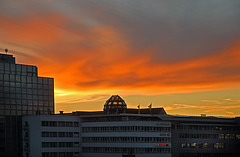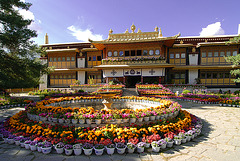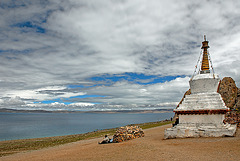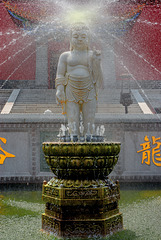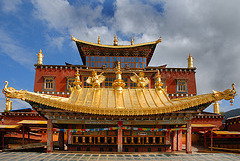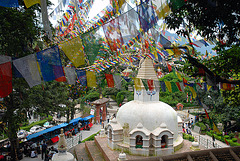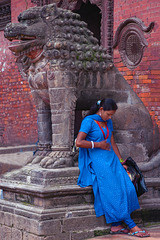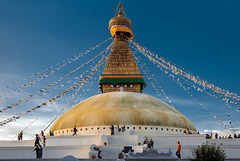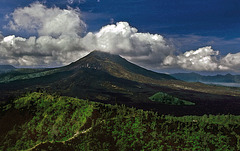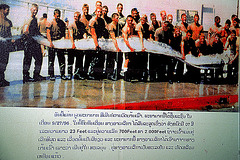Wolfgang's photos
At an intersection on the Sukhumvit Road in Bangko…
| |
|
|
|
Motorcycles waiting at an intersection, some starting before traffic light turns to green.
Munich Hauptzollamt in sunset mood
Dakshin Kali
| |
|
|
The temple at Dakshin Kali is dedicated to the ferocious mother goddess who has much energy and power. It is said that she gives strong will power and energy to those who come to her and she loves sacrifices. The temple is tantric in nature and is a favourite worship place of the Hindus. Saturdays are good days to visit as there is always a massive crowd of worshippers who come from all parts of Nepal to offer prayers.
Budhanilkantha Lying Vishnu Nepal
| |
|
|
A few kilometers north of Kathmandu, at the base of the Sivapuri hills is a remarkable statue of Lord Vishnu, reclining on a bed of coiled snakes. The statue said to be sculpted from a single block stone, is set in the middle of a small pond and appears to be floating in the water.
The stone image is said to be one of three statues sculpted during the Lichhavi period and called Budhanilkantha named after the huge image of Lord Vishnu. The five meter long statue called Bhuijassi by the local Newaris of the Liccchivi – age settlement at the base of Shivapuri hills is also known as Budhanilkanta. The village, now also known as Budhanilkantha, used to be called Thaturi Drung’ during ancient times.
Lhasa Norbulingka Summer Palace
| |
|
|
Norbulingka, meaning 'Treasure Park' in Tibetan, is situated in the western suburb of Lhasa City, at the bank of the Kyichu River, about one km southwest of Potala Palace. The garden covers an area of 360,000 square meters, with 374 rooms inside. It is the biggest man-made gardens in Tibet Autonomous Region.
Construction began in the 1740s. The area used to be wasteland with wild animals, weeds and scrub which the Seventh Dalai Lama liked and often visited, and, as a result, the Qing magistrate had a palace built. Years later, Kelsang Potrang was built by order of the Seventh Dalai Lama. Later it was used as the Summer Palace for successive Lamas, where they solved the political problems and held festive celebrations. After a series of expansions and renovations, the appearance was improved with potrangs, pavilions, gardens and woods. It has now been turned into a park open to the public.
Lhasa and the Potala
| |
|
|
|
The Potala Palace rises a further 170 meters and is the greatest monumental structure in all of Tibet. Early legends concerning the rocky hill tell of a sacred cave, considered to be the dwelling place of the Bodhisattva Chenresi (Avilokiteshvara), that was used as a meditation retreat by Emperor Songtsen Gampo in the seventh century AD. In 637 Songtsen Gampo built a palace on the hill. This structure stood until the seventeenth century, when it was incorporated into the foundations of the greater buildings still standing today. Construction of the present palace began in 1645 during the reign of the fifth Dalai Lama and by 1648 the Potrang Karpo, or White Palace, was completed. The Potrang Marpo, or Red Palace, was added between 1690 and 1694; its construction required the labors of more than 7000 workers and 1500 artists and craftsman. In 1922 the 13th Dalai Lama renovated many chapels and assembly halls in the White Palace and added two stories to the Red Palace. The Potala Palace was only slightly damaged during the Tibetan uprising against the invading Chinese in 1959. Unlike most other Tibetan religious structures, it was not sacked by the Red Guards during the 1960s and 1970s, apparently through the personal intervention of Chou En Lai. As a result, all the chapels and their artifacts are very well preserved.
Yak bull nearby the Namtso Lake Tibet
| |
|
|
Summer is the best time for Namtso Lake. Wild yaks, hares and other wild animals leisurely look for food along the expansive lake shores; countless migratory birds fly here to lay eggs and feed their young; sometimes lovely fishes in the lake jump out of the lake water, enjoying the warmth of the sunshine; sheep and cows herds are like flowing white blanks on the green grassland which can stretch as far as your eyes can see; the dulcet songs of Gauchos resound through the valleys. This time of the year Namtso Lake is full of life and activity. Therefore it is no wonder Tibetans take Namtso Lake the symbol of goodliness and happiness. Really Namtso Lake is a blessing from nature.
Stupa at the Namtso Lake Tibet
| |
|
|
|
Namtso Lake in the Tibet Autonomous Region was selected as one of the five most beautiful lakes in China by Chinese National Geography magazine. Namtso Lake's touching beauty should not be missed by any traveler who visits Tibet. Its purity and solemnness are symbols of Qinghai-Tibet Platean. In Tibetan, Namtso means 'Heavenly Lake.' It is considered one of the three holy lakes in Tibet. Namtso is famous for its high altitude (4718 meters), vast area (1961 square kilometers) and beautiful scenery.
Being the second largest saltwater lake in China only after Qinghai Lake, Namtso is the biggest lake throughout Tibet. Meanwhile, it is the highest altitude saltwater lake in the world. The water here is a storybook crystal-clear blue. Clear skies join the surface of the lake in the distance, creating an integrated, scenic vista. Soul of every visitor who has ever been here seems to be cleansed by the pure lake water.
Namtso Lake maintains its levels from rainfall and melted snow flowing from high mountains. Five islands stand in the waters of the lake, among which the largest one is Liangduo island. In addition another five bylands stretch into the lake from different directions. Zhaxi byland is the largest in area of these five. A great many bizarre stone peaks can be found on this byland. Some of them are like trunks; some look like human beings; some resemble trees. Various kinds of vivid shapes can easily arouse your imagination. At the same time there are many quiet grottos which are masterpieces of nature. Some grottos are narrow and long like subways; some are full of stalactites; still, others are like louvers. Queer rocks, steep peaks, natural stone ladders and other landform wonders on Zhaxi byland present visitors a picture filled with mystery and enchantment.
Lhasa monks debating inside the Sera Monastery
| |
|
|
As a part of their study, lamas must participate in debates to further their comprehension and proceed to more advanced levels of study. The debating traditions in the Sera Monastery are unique among the three famous monasteries in Lhasa. Debates are conducted by the lamas in the monastery every day beginning at 3.a.m. In a battle of words, they supplement their efforts by using a variety of gestures including clapping their hands, pushing their partners for an answer, or plucking their prayer beads to win the virtue of the Buddha.
Young Buddha Statue in Dali, Yunnan
| |
|
|
This statue of an young Buddha image was seen inside the Three Pagodas Complex in Dali.
Zhongdian Songzanlin Monastery
| |
|
|
|
In 1679, Dalailama chose this place by divination, and it went on to become the uppermost public place in Yunnan which features the particular local characteristics. Annually, the Gedong Festival is celebrated here by the Tibetans. Pious believers, with their knees and foreheads knocking the ground at every step, come here to pray.
Actually Zhongdian and this monastery is located in the formaly eastside of Tibet, now in the province Yunnan.
Swayambhunath Complex Kathmandu Nepal
| |
|
|
This stupa isn't well known by the tourists visiting the Swayambhunath Temple Hill in Kathmandu. If you use the steps entering Swayambhunath from the northern side you'll pass this stupa and Shantipur.
Patan Nepal
| |
|
|
|
Beautiful typical dressed Newa girl in front of Mul Chowk buidling.
The Newa (Nepal Bhasa:नेवाः Newa or Newah, Old Nepal Bhasa:नेवार Newar, नेवाल Newal) are the indigenous people of Nepal's Kathmandu Valley. Newars are a linguistic community with multiple ethnicity/race and faith, bound together by a common language. The term Newar applies roughly to the descendants of citizens of Medieval Nepal (consisting of Kathmandu valley as the capital and the territory ever changing with farest extent being Gandaki river to west and Koshi river to the east, Tibet to north and Terai in south). Their common language being Nepal Bhasa ("Newari" according to Statistics Nepal) or the languages progenitor of Nepal Bhasa. According to Nepal’s 2001 census, the 1,245,232 Newar in the country are the nation's sixth largest ethnic group, representing 5.48% of the population. Nepal Bhasa is of Tibeto-Burman origin (but heavily influenced by Indo-Aryan languages like Sanskrit, Pali, Bengali and Maithili). Nepal Bhasa also contains Austro-Asiatic words and phrases. In 2001 the language is spoken by 825,458 Nepalese as their mother tongue.
Bodnath Kathmandu Nepal is one of Tibetan souls
| |
|
|
|
Bodnath isn't located in Tibet, but its Tibetan culture
Bodnath, also called Boudhanath or Baudhanath or the Khāsa Caitya is one of the holiest Buddhist sites in the area of Kathmandu, Nepal. It is known as Khāsti by Newars as Bauddha or Bodh-nāth by modern speakers of Nepali. It is located about 11 km from the centre of Kathmandu, Nepal on the northeastern outskirts of the city. Its platform is a massive mandala and it is the largest spherical stupa in Nepal.
The Buddhist stupa of Boudhanath dominates the skyline. The ancient Stupa is one of the largest in the world. The influx of large populations of Tibetan refugees from China has seen the construction of over 50 Tibetan Gompas (Monasteries) around Boudhanath. Boudhanath is one of the sites in Nepal listed as UNESCO World Heritage Sites. Along with Swayambhunath, to the western side of the city centre, it is one of the most popular tourist sites in Kathmandu city.
The Stupa is on the ancient trade route from Tibet which enters the Kathmandu Valley by the village of Sankhu in the northeast corner, passes by Boudnath Stupa to the ancient and smaller stupa of Cā-bahī (often called 'Little Boudnath'). It then turns directly south, heading over the Bagmati river to Patan - thus bypassing the main city of Kathmandu (which was a later foundation). Tibetan merchants have rested and offered prayers here for many centuries. When refugees entered Nepal from Tibet in the 1950s, many decided to live around Bouddhanath. The Stupa is said to entomb the remains of a Kasyapa sage venerable both to Buddhists and Hindus.
Batur Volcano Bali Indonesia
| |
|
|
|
The historically active Mount Batur (Gunung Batur) is located at the center of two concentric calderas north west of Mount Agung, Bali, Indonesia. The south east side of the larger 10×13 km caldera contains a caldera lake. The inner 7.5-kilometer-wide caldera, which was formed during emplacement of the Bali (or Ubud) ignimbrite, has been dated at about 23,670 and 28,500 years ago.
The SE wall of the inner caldera lies beneath Lake Batur; Batur cone has been constructed within the inner caldera to a height above the outer caldera rim. The Batur stratovolcano has produced vents over much of the inner caldera, but a NE-SW fissure system has localized the Batur I, II, and III craters along the summit ridge. Historical eruptions have been characterized by mild-to-moderate explosive activity sometimes accompanied by lava emission. Basaltic lava flows from both summit and flank vents have reached the caldera floor and the shores of Lake Batur in historical time. The caldera contains an active, 700-metre-tall stratovolcano rising above the surface of Lake Batur. The first historically documented eruption of Batur was in 1804, and it has been frequently active since then.
Marines from USA catching a Nāga snake
| |
|
|
This photo shot was made during the Vietnamese war when soldiers from USA catch a 7 Meter long Nāga snake out the Mekong river. Most people believe on the truth of this photo but its obviously manipulated.
The legend of the Nāga is a strong and sacred belief held by Cambodian, Lao and Thai people living along the Mekong River. Many pay their respects to the river because they believe the Nāga still rule in it, and locals hold an annual sacrifice for the Nāga. Each ceremony depends on how an individual village earns its living from the Mekong River - for instance, through fishing or transport. Local residents believe that the Nāga can protect them from danger, so they are likely to make a sacrifice to Nāga before taking a boat trip along the Mekong River.

